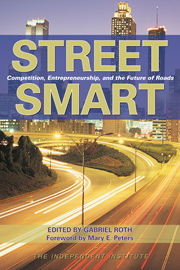The August collapse of the Interstate 35W bridge has sparked a flurry of action. Governors around the nation have ordered immediate safety inspections of highway bridges, and Congress has ostentatiously appropriated a billion dollars for bridge repairs. The implication is that this tragedy has finally generated effective measures to address roadway needs.
This implication is false. The evidence for a decaying roadway infrastructure has been accumulating for years. The Federal Highway Administration has classified 27 percent of the nation’s roadway bridges as “deficient,” and the U.S. Department of Transportation has identified a backlog of $65 billion in needed bridge repairs and $600 billion in other work that will not be funded by current revenue.
In the face of this mounting evidence that the roadway asset is decaying, Congress earmarked $24 billion for pork-barrel road projects in the most recent highway funding bill. This included the notorious $233 million “bridge to nowhere” in Alaska.
Why does this kind of nonsense persist? Because the government owns the roads. This means that rather than being managed using sound investment judgment, roads are managed by a bureaucracy toiling under the mandates of politically determined priorities.
The havoc that government ownership and operation of the roads engenders is illustrated by the way in which roads are financed. While road financing is somewhat tied to use, in that fees and taxes assessed on vehicles and fuel provide the bulk of the money, political pressures have distorted the way these fees and taxes have been set.
Consider: Everyone knows that heavy vehicles impose substantially larger costs for building and maintaining roads, yet studies consistently show that these vehicles are undercharged in relation to these costs. A well-organized trucking lobby has been successful in persuading state and federal legislators to shift costs to lighter vehicles and general taxpayers.
In effect, trucking operations are subsidized. The consequences include accelerated wear and tear on the roadways, diversion of freight traffic from rail, and increased roadway congestion. All of these consequences raise the cost of transportation and reduce the efficiency of the road system.
Subsidies to heavy-vehicle traffic are only one example of how public ownership and political management of roads lead to inefficient outcomes. Congress also has mandated that highway user fees be diverted to subsidize public transportation.
The notion is that these subsidies would help reduce traffic congestion by providing more options for urban travelers. With few exceptions, though, the total cost per person-mile on public transportation far exceeds the total cost per person-mile for travel by private automobile. In most cases, more congestion relief would be obtained from expanding roadway capacity than by subsidizing public transit.
The decay of the road asset, the inequitable treatment of roadway users, the inefficiencies of the public sector: That such a socialistic model for providing such a vital service is inapt should be readily apparent from the global trend away from socialism toward more market-oriented approaches for meeting material needs.
Privatizing roadways would help overcome the most egregious problems of the current system. Private investors need to recover their costs in order to stay in business. Undercharging some customers and neglecting maintenance are chronic and inherent when the government runs things. They are rare news items when private firms run things.








